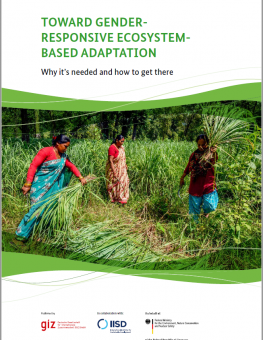
Toward Gender-Responsive Ecosystem-based Adaptation
Why it's needed and how to get there
A key factor for the success of ecosystem-based adaptation (EbA) initiatives is the active integration of gender considerations. By working to address gender and social inequalities, EbA initiatives can be more effective and more sustainable.
This publication is also available in Spanish. | Esta publicación está disponible en español.
Climate change and the biodiversity crisis are driving demand for actions that build the long-term resilience of societies, ecosystems, and economies. EbA uses natural systems to build the resilience of ecosystems, as well as the communities that depend on them. This process provides an opportunity to actively promote gender equality when applying a gender-responsive approach.
Toward Gender-Responsive Ecosystem-Based Adaptation: Why It's Needed and How to Get There provides an understanding of the importance of using a gender-responsive approach to EbA. This report describes key building blocks for effective and gender-just EbA, and includes on-the-ground examples of them being put into practice. The guidance and recommendations provided by this report can help EbA practitioners and adaptation policy-makers, whether in governments, research institutions, businesses, or civil society.
Authored by International Institute for Sustainable Development (IISD) experts, this report was made possible by the Deutsche Gesellschaft für Internationale Zusammenarbeit (GIZ) GmbH.
You might also be interested in
Gender-Responsive Climate Action
What does gender-responsive climate action look like? Expert commentary on achieving gender-responsive climate action through women’s empowerment, inclusive policy-making and other innovative practices.
Why Gender Matters in Climate Change Adaptation
Effective climate change adaptation recognizes that women, men and children experience impacts differently depending on where they live, how they sustain their livelihoods, and the roles they play in their families and communities.
Building Resilience With Nature: Ecosystem-based Adaptation in National Adaptation Plan Processes
This analysis provides a better understanding of the extent to which EbA, as a tool for adaptation, can be integrated into NAP processes.
How to Make Nature-Based Solutions for Adaptation Work for Everyone
Effective nature-based solutions (NbS) for adaptation start with integrated climate risk assessments. These take-aways will help practitioners plan for inclusive and sustainable NbS.
